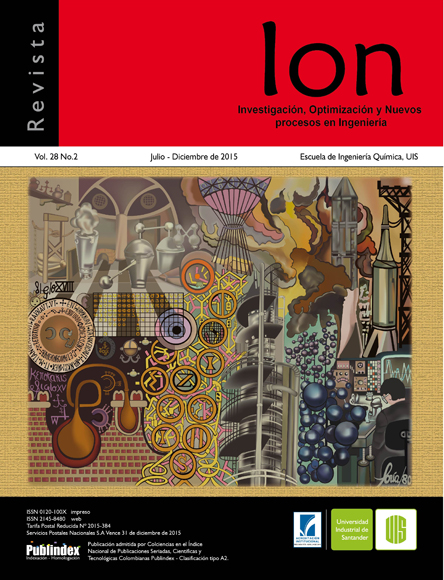Efeito da temperatura e da concentração sobre as propriedades reológicas de polpa de manga variedade Tommy Atkins
Publicado 2015-12-30
Palavras-chave
- Reologia,
- Viscosidade Aparente,
- Seudoplástica,
- Índice de Consistência.
Como Citar
Resumo
Manga Tommy Atkins é uma das variedades mais exploradas na indústria e marketing global. É apreciada pela sua longa vida e baixa degradação no manuseio e transporte. O rendimento da polpa é elevada, entre 60 e 75% do peso total do fruto, e é utilizado na indústria de refrescos, néctares, compotas e polpa concentrada. Neste artigo de investigação, os resultados do estudo de comportamento e parâmetros reológicos de polpa de manga concentrado (Mangifera indica L.) Tommy Atkins, na gama de temperaturas de 15-60°C e na gama de concentração de 15-30°Brix, são mostrados. Para isso, foi utilizado um viscosímetro Brookfield modelo DV-II + Pro (R). Polpa de manga apresentou um comportamento pseudoplástico não-newtoniano em todas as temperaturas e concentrações. A relação entre a tensão de corte e velocidad de cizallae foi modelado pelo modelo de lei de Potência ou de Ostwald de Waele. O Modelo de Arrhenius e equação de Potência foram devidamente ajustados aos dados experimentais da viscosidade aparente da polpa em relação à temperatura e concentração. Os valores vão melhorar a concepção de equipamentos de transporte e tratamento térmico de polpa de manga Tommy Atkins.
Downloads
Referências
[2] Holdsworth SD. Applicability of rheological models to the interpretation of flow and processing behaviour of fluid food products. J Texture Stud. 1971;2:393-418.
[3] Vitali AA, Rao MA. Flow properties of low-pulp concentrated orange juice: Effect of temperature and concentration. J Food Sci.1984;49:882-8.
[4] Hernandez E, Chen CS, Johnson J, Carter RD. Viscosity changes in orange juice after ultrafiltration and evaporation. J Food Eng. 1995;25(3):387-96.
[5] Ahmed J, Shivhare U, Raghavan G. Rheological characteristics and kinetics of color degradation of green chilli puree. J Food Eng. 2000;44(4):239-44.
[6] Ahmed J, Shivhare U, Singh, P. Colour kinetics and rheology of coriander leaf puree and storage characteristics of the paste. Food Chem. 2004;84:604-11.
[7] Haminiuk C, Sierakowski M, Vidal J, Masson M. Influence of temperature on the rheological of whole araҫá pulp (Psidium cattleianum sabine). Lebensm Wiss Technol. 2006;39:426-30.
[8] Pelegrine D, Silva F, Gasparetto C. Rheological Behvior of Pineapple and Mango Pulps. Lebensm Wiss Technol. 2002;35:645-8.
[9] Steffe JF. Rheological methods in food process engineering. 2 ed. Estados Unidos: Freeman Press; 1996.
[10] Dak M, Verma R, Sharma G. Flow characteristics of juice of “Totapuri” mangoes. J Food Eng. 2006;76:557-61.
[11] Branco IG, Gasparetto C. A response surface methodology applied to the study of temperature effect on the rheological behavior of ternaries mixtures with mango pulp and orange and carrot juices. Ciênc Tec Alim. 2003;23:166-71.
[12] Malkin A, Isayev A. Rheology: Concepts, Methods, and Applications. 2 ed. Canadá: ChemTec Publishing; 2012.
[13] Mackey KL, Ofoli RY, Morgan RG, Steffe JF. Rheological modeling of potato flour during extrusion cooking. J. Food Proc. Eng.1989;12:1-11.
[14] Dak M, Verma R, Jaaffrey S. Effect of temperature and concentration on Rheological properties of “Kesar” mango juice. J Food Eng. 2007;80:1011-5.
[15] A.O.A.C. Official Methods of Analysis of the Association of Official Analytical Chemist. Estados Unidos: Editorial Association of Official Analytical Chemists; 1990.
[16] Ramos AM, Ibarz A. Thixotropy of orange concentrate and quince puree. J Texture Stud.1998;29(3):313-24.
[17] Sharma S, Le Maguer M, Liptay A, Poysa V. Effect of composition on the reological properties of tomato thin pulp. Food Res Int.. 1996;29(2):175-9.
[18] Krokida MK, Maroulis ZB, Saravacos GD. Rheological properties of fluid fruit and vegetable puree products: compilation of literature data. Int J Food Properties. 2001;4(2):179-200.
[19] Khandari P, Gill BS, Sodhi NS. Effect of concentration and temperature on the Rheology of mango pulp. J. Food Sci. Technol. 2002;39(2):152-4.
[20] Rao MA, Bourne MC, Cooley HJ. Flow properties of tomato concentrates. J Texture Stud. 1981;12:521-38.
[21] Dak M, Charan R, Kumar M. Mathematical models for prediction of rheological parameters of pineapple juice. Int J Food Eng. 2008;4(3):1-16.
[22] Dak M, Charan R, Jaaffrey SN. Rheological properties of tomato concentrate. Int J Food Eng. 2008;4(7):1-17.
[23] Vitali AA, Rao M.A. Flow properties of low-pulp concentrated orange juice: effect of temperature and concentration. J. Food Sci. 1984;49;882-8.
[24] Kaya A, Belibagli K. Rheology of solid Gaziantep Pekmez. J Food Eng. 2002;54:221-6.
[25] Juszczak L, Fortuna T. Effect of temperature and soluble solid content on the viscosity of cherry juice concentrate. Int Agrophysics. 2004;18:17-21.
[26] Kaya A, Sözer N. Rheological behavior of sour pomegranate juice concentrates (Punica granatum L.). Int J Food Sci Tech. 2005;40:223-7.
[27] Quek M, Chin N, Yusof Y. Modelling of rheological behaviour of soursop juice concentrates using shear rate–temperature–concentration superposition. J Food Eng. 2013;118(4):380-5.
[28] Toǧrul H, Arslan N. Mathematical model for prediction of apparent viscosity of molasses. J Food Eng. 2004;62:281-9.
[29] Chin NL, Chan SM, Yusof YA, Chuah TG, Talib RA. Modelling of rheological behaviour of pummelo juice concentrates using master-curve. J Food Eng. 2009;93(2):134-40.
[30] Chuah T, Ling H, Chin N, Choong T, Razi F. Effects of temperature on Rheological Behavior of Drgaon Fruit (Hylocereus sp.) Juice. Int J Food Eng. 2008;4(7):1-28.

